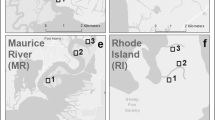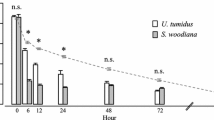Abstract
Zebra mussel filtration rates and regulating factors have been addressed earlier in a number of studies. Still, only a few of them have taken into consideration the refiltration phenomenon, and therefore the direct extrapolation of experimental results may only give the potential filtering capacity, and hence, over- or underestimate the actual amount of seston being removed by zebra mussels in an ecosystem. The current experimental study aimed to gain insight into the refiltration effect on the clearance rate of the zebra mussels at relatively high seston concentrations, and its potential role in controlling the filtration efficiency of the zebra mussel population. The experiment was conducted in a laboratory flume following the Latin squares design with one fixed (mussel density) and three random factors (initial total particulate matter (TPM) concentration, flume “wall effect” and distance from the flume inflow area) considered. The results showed the significant effects of mussel density and the TPM concentration on the effective clearance rate (ECR) of zebra mussels. The higher ECR values were obtained at denser mussel clumps and lower TPM concentrations. The flume “wall effect” had no significant effect on the ECR, whereas the distance from the flume inflow area appeared to have a significant impact. A positive relationship between ECR and the zebra mussel density was most evident in the proximity of the TPM source. Based on the results, we assume that at high TPM concentration, refiltration may assert itself by the elevated net clearance rate of mussels within dense clumps compared to that of mussels at relatively low individual densities. This should be taken into consideration while modelling and assessing the role of the zebra mussel in energy flow and redistribution of organic matter in an ecosystem.






Similar content being viewed by others
References
Beutler, M., K. H. Wiltshire, B. Meyer, C. Moldaenke, C. Lüring, M. Meyerhöfer, U.-P. Hansen & H. Dau, 2002. A fluorometric method for the differentiation of algal populations in vivo and in situ. Photosynthesis Research 72: 39–53.
Dame, R. F., 1996. Ecology of marine bivalves: an ecosystem approach. CRC Press, Boca Raton: 254.
Daunys, D., P. Zemlys, S. Olenin, A. Zaiko & C. Ferrarin, 2006. Impact of the zebra mussel Dreissena polymorpha invasion on the budget of suspended material in a shallow lagoon ecosystem. Helgoland Marine Research 60: 113–120.
De Villiers, C. J. & A. N. Hodgson, 1993. The filtration and feeding physiology of the infaunal estuarine bivalve Solen cylindraceus Hanley 1843. Journal of Experimental Marine Biology and Ecology 167: 127–142.
Fanslow, D. L., T. F. Nalepa & G. A. Lang, 1995. Filtration rates of the zebra mussel (Dreissena polmorpha) on natural seston from Saginaw Bay, Lake Huron. Journal of Great Lake Research 21: 489–500.
Foster-Smith, R. L., 1975. The effect of concentration of the suspension on the filtration rates and pseudofecal production for Mytilus edulis L., Cerastoderma edule L. and Venerupis pullastra (Montagu). Journal of Experimental Marine Biology and Ecology 17: 1–22.
Galkus A, Jokšas K (1997) Sedimentary material in the transitional aquasystem. Institute of geography, Vilnius, p 198 (in Lithuanian with English summary).
Gasiūnaitė, Z. R., D. Daunys, S. Olenin & A. Razinkovas, 2008. The Curonian Lagoon. In Schiewer, U. (ed.), Ecology of Baltic Coastal Waters. Ecological studies 197. Springer-Verlag, Berlin Heidelberg: 197–215.
Herman P. M. J., 1993. A set of models to investigate the role of benthic suspension feeders in estuarine ecosystems. In Dame, R. F. (ed.), Bivalve filter feeders in estuarine and coastal ecosystem processes. Springer-Verlag, Berlin: 421–454
Horgan, M. J. & E. L. Mills, 1997. Clearance rates and filtering activity of zebra mussel (Dreissena polymorpha): implications for freshwater lakes. Canadian Journal of Fisheries and Aquatic Sciences 54: 249–255.
Idrisi, N., E. L. Mills, L. G. Rudstam & D. J. Stewart, 2001. Impact of zebra mussels (Dreissena polymorpha) on the pelagic lower trophic levels of Oneida Lake, New York. Canadian Journal of Fisheries and Aquatic Sciences 58: 1430–1441.
Karatayev, A. Y., & L. E. Burlakova, 1994. Filtration rates. In: Starobogatov JI (ed) Freshwater zebra mussel Dreissena polymorpha (Pall.) (Bivalvia, Dreissenidae): systematics, ecology, practical meaning. Nauka, Moscow: 109–120 (in Russian).
Karatayev, A. Y., L. E. Burlakova & D. K. Padilla, 2002. Impacts of zebra mussels on aquatic communities and their role as ecosystem engineers. In Leppäkoski, E., S. Gollasch & S. Olenin (eds), Invasive aquatic species of Europe – distribution, impact and management. Kluwer Academic Publishers, Dordrecht Boston London: 433–446.
Kelly, D. W., L.-M. Herborg & H. J. MacIsaac, 2010. Ecosystem changes associated with Dreissena invasions: recent developments and emerging issues. In van der Velde, G., S. Rajgopal & A. Bij de Vaate (eds), The zebra mussel in Europe. Backhuys Publishers, Leiden, the Netherlands: 199–210.
Kotta, J. & F. Møhlenberg, 2002. Grazing impact of Mytilus edulis and Dreissena polymorpha (Pallas) in the Gulf of Riga, Baltic Sea estimated from biodeposition rates of algal pigments. Annales Zoologici Fennici 39: 151–160.
Kotta, J., H. Orav I. Kotta, 1998. Distribution and filtration activity of the zebra mussel, Dreissena polymorpha, in the Gulf of Riga and the Gulf of Finland. Proceedings of the Estonian Academy of Sciences 47: 32–41.
Kotta J, H. Orav-Kotta & I. Vuorinen (2005) Field measurements on the variability in biodeposition and grazing pressure of suspension feeding bivalves in the northern Baltic Sea. In: Dame R and Olenin S (eds) The Comparative Roles of Suspension Feeders in Ecosystems, Vol. 47. Springer, Dordrecht: 11–29.
Kryger, J. & H. U. Riisgård, 1988. Filtration rate capacities in 6 species of European freshwater bivalves. Oecologia 77: 34–38.
Lauringson, V., E. Mälton, J. Kotta, K. Kangur, H. Orav-Kotta & I. Kotta, 2007. Environmental factors influencing the biodeposition of the suspension feeding bivalve Dreissena polymorpha (Pallas): comparison of brackish and fresh water populations in the Northern Baltic Sea and Lake Peipsi. Estuarine, Coastal and Shelf Science 75: 459–467.
Makarewicz, J. C., P. Bertram & T. W. Lewis, 2000. Chemistry of the offshore surface waters of Lake Erie: Pre- and post-Dreissena introduction (1983–1993). Journal of Great Lake Research 26: 82–93.
Mikheev, V. P., 1967. Filtration nutrition of the Dreissena. Trudy Vsesoyuznogo nauchno-isskdovatel’skogo Instituta 15: 117–129. (in Russian).
Nicholls, K. H., 2001. CUSUM phytoplankton and chlorophyll functions illustrate the apparent onset of dreissenid mussel impacts in Lake Ontario. Journal of Great Lake Research 27: 393–401.
Olenin S. & D. Daunys, 2005. Invaders in suspension-feeder systems: variations along the regional environmental gradient and similarities between large basins. In: Dame R and Olenin S (eds) The Comparative Roles of Suspension Feeders in Ecosystems, Vol. 47. Springer, Dordrecht: 221-237.
Pilkaitytė, R. & A. Razinkovas, 2007. Seasonal changes in phytoplankton composition and nutrient limitation in a shallow Baltic lagoon. Boreal Environmental Research 12: 551–559.
Reeders, H. H. & A. bij de Vaate, 1990. Zebra mussels (Dreissena polymorpha): a new perspective for water quality management. Hydrobiologia 200(201): 437–450.
Reeders, H. H., A. bij de Vaate & F. J. Slim, 1989. The filtration rate of Dreissena polymorpha (Bivalvia) in three Dutch lakes with reference to biological water quality management. Freshwater Biology 22: 133–141.
Reeders, H. H., A. bij de Vaate & R. Noordhuis, 1993. Potential of the zebra mussel (Dreissena polymorpha) for water quality management. In Nalepa, T. F. & D. W. Schloessers (eds), Zebra mussels: biology, impacts, and control. Lewis Publishers, Boca Raton, Ann Arbor, London, Tokyo: 439–451.
Vanderploeg, H. A., T. F. Nalepa, D. J. Jude, E. L. Mills, K. T. Holeck, J. R. Liebig, I. A. Grigorovich & H. Ojaveer, 2002. Dispersal and emerging ecological impacts of Ponto-Caspian species in the Laurentian Great Lakes. Canadian Journal of Fisheries and Aquatic Sciences 59: 1209–1228.
Walz, N., 1978. The energy balance of the fresh mussel Dreissena polymorpha Pallas in laboratory experiments and in Lake Constance. I. Pattern of activity, feeding and assimilation efficiency. Archiv für Hydobiologie 55: 83–105.
Yu, N. & D. A. Culver, 1999. Estimating the effective clearance rate and refiltration by zebra mussels, Dreissena polymorpha, in a stratified reservoir. Freshwater Biology 47: 481–492.
Zaiko, A., R. Paškauskas & A. Krevš, 2010. Biogeochemical alteration of benthic environment by zebra mussel Dreissena polymorpha (Pallas). Oceanologia 52: 649–667.
Zemlys P, Daunys D, Olenin S (2001) Modelling of the zebra mussel impact on the Curonian lagoon ecosystem. Report, Klaipeda University: 33 pp (in Lithuanian).
Acknowledgments
This study was supported by Theme 6 of the EC seventh framework program through the Marine Ecosystem Evolution in a Changing Environment (MEECE No 212085) Collaborative Project and the EU (European Regional Development Fund) through the Baltic Sea Region Programme project, Sustainable Uses of Baltic Marine Resources (SUBMARINER No. 055). Also we acknowledge the constructive and objective comments provided by the two anonymous reviewers.
Author information
Authors and Affiliations
Corresponding author
Additional information
Handling editor: Luigi Naselli-Flores
Rights and permissions
About this article
Cite this article
Zaiko, A., Daunys, D. Density effects on the clearance rate of the zebra mussel Dreissena polymorpha: flume study results. Hydrobiologia 680, 79–89 (2012). https://doi.org/10.1007/s10750-011-0904-0
Received:
Revised:
Accepted:
Published:
Issue Date:
DOI: https://doi.org/10.1007/s10750-011-0904-0




